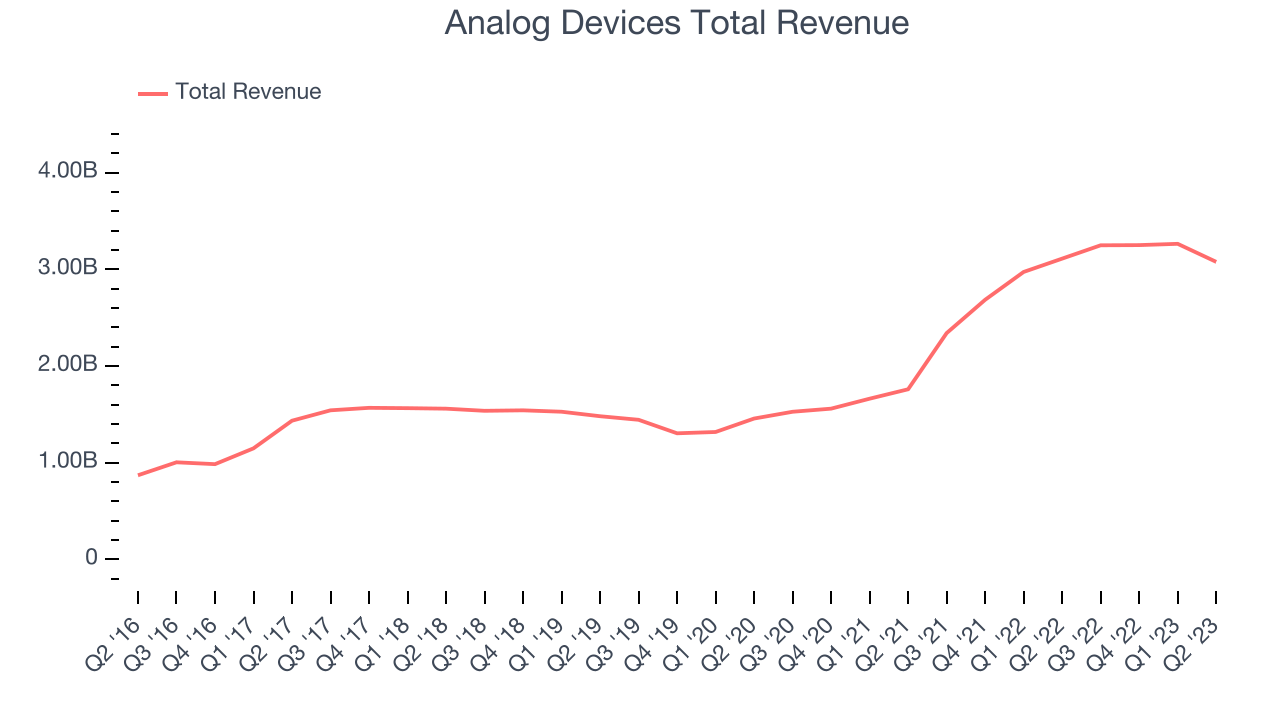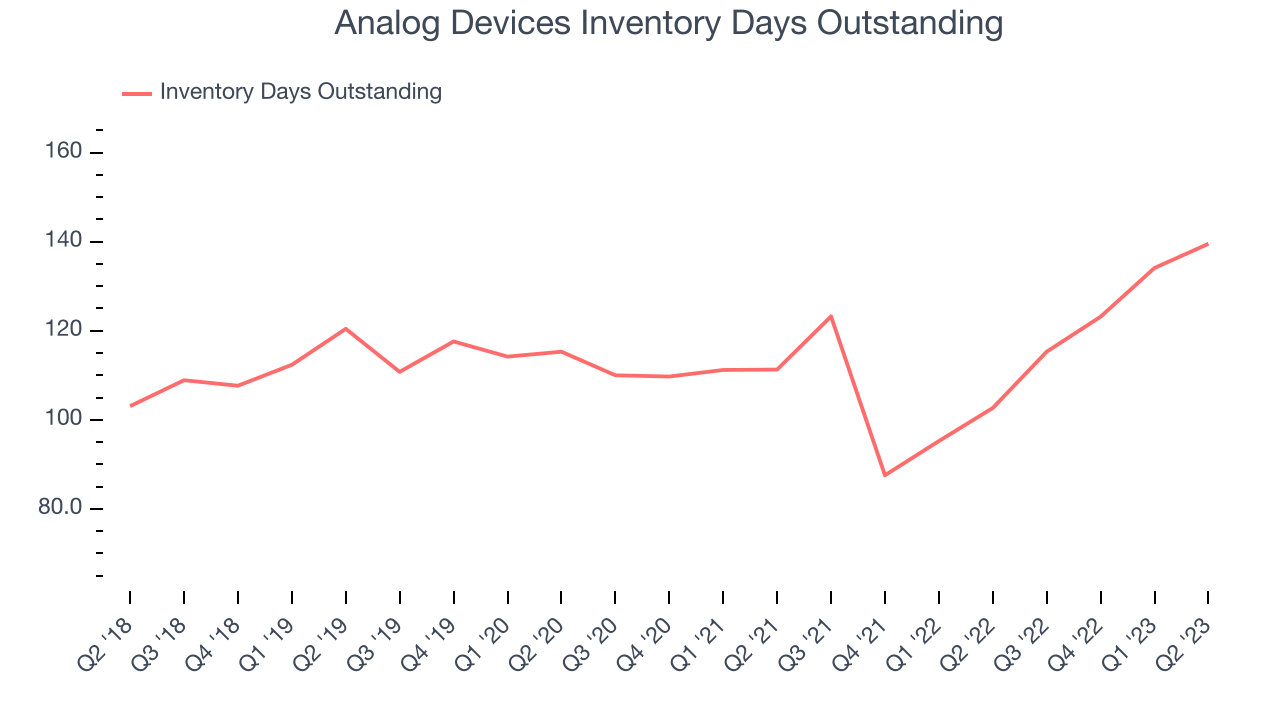Manufacturer of analog chips, Analog Devices (NASDAQ:ADI) missed analysts' expectations in Q3 FY2023, with revenue down 1.07% year on year to $3.08 billion. The company's full-year revenue and EPS guidance also fell short of Wall Street's estimates. Analog Devices made a GAAP profit of $877 million, improving from its profit of $749 million in the same quarter last year.
Is now the time to buy Analog Devices? Find out by accessing our full research report, it's free.
Analog Devices (ADI) Q3 FY2023 Highlights:
- Revenue: $3.08 billion vs analyst estimates of $3.1 billion (0.9% miss)
- EPS (non-GAAP): $2.49 vs analyst expectations of $2.52 (1.37% miss)
- Revenue Guidance for Q4 2023 is $2.7 billion at the midpoint, below analyst estimates of $3.03 billion
- Free Cash Flow of $817.9 million, similar to the previous quarter
- Inventory Days Outstanding: 140, up from 134 in the previous quarter
- Gross Margin (GAAP): 63.8%, down from 65.7% in the same quarter last year
“In a challenging operating environment, ADI executed well, and delivered third quarter results within our expectations. However, the customer inventory adjustments we mentioned last quarter have accelerated as economic conditions deteriorate and our lead times continue to improve,” said Vincent Roche, CEO and Chair.
Founded by two MIT graduates, Ray Stata and Matthew Lorber in 1965, Analog Devices (NASDAQ:ADI) is one of the largest providers of high performance analog integrated circuits used mainly in industrial end markets, along with communications, autos, and consumer devices.
Demand for analog chips is generally linked to the overall level of economic growth, as analog chips serve as the building blocks of most electronic goods and equipment. Unlike digital chip designers, analog chip makers tend to produce the majority of their own chips, as analog chip production does not require expensive leading edge nodes. Less dependent on major secular growth drivers, analog product cycles are much longer, often 5-7 years.
Sales Growth
Analog Devices's revenue growth over the last three years has been very strong, averaging 35.2% annually. But as you can see below, its revenue declined from $3.11 billion in the same quarter last year to $3.08 billion. Semiconductors are a cyclical industry, and long-term investors should be prepared for periods of high growth followed by periods of revenue contractions (which can sometimes offer opportune times to buy).

Analog Devices had a difficult quarter as revenue dropped 1.07% year on year, missing analysts' estimates by 0.9%.
Analog Devices's revenue inverted from positive to negative growth this quarter, which was unfortunate to see. Looking ahead to the next quarter, the company's management team forecasts a 16.9% year-on-year revenue decline. Analysts seem to agree that the poor performance will continue, as their estimates for the next 12 months call for a 5.32% drop in revenue.
The pandemic fundamentally changed several consumer habits. There is a founder-led company that is massively benefiting from this shift. The business has grown astonishingly fast, with 40%+ free cash flow margins. Its fundamentals are undoubtedly best-in-class. Still, the total addressable market is so big that the company has room to grow many times in size. You can find it on our platform for free.
Product Demand & Outstanding Inventory
Days Inventory Outstanding (DIO) is an important metric for chipmakers, as it reflects a business' capital intensity and the cyclical nature of semiconductor supply and demand. In a tight supply environment, inventories tend to be stable, allowing chipmakers to exert pricing power. Steadily increasing DIO can be a warning sign that demand is weak, and if inventories continue to rise, the company may have to downsize production.

This quarter, Analog Devices's DIO came in at 140, which is 26 days above its five-year average, suggesting that the company's inventory has grown to higher levels than we've seen in the past.
Key Takeaways from Analog Devices's Q3 Results
With a market capitalization of $88.6 billion, a $1.15 billion cash balance, and positive free cash flow over the last 12 months, we're confident that Analog Devices has the resources needed to pursue a high-growth business strategy.
We struggled to find many strong positives in these results. Analog Devices's revenue missed Wall Street's estimates, its revenue guidance for next quarter underwhelmed, and it lowered its margin expectations, partly due to customer inventory adjustments it had to make. CEO Vincent Roche noted that from his point of view, economic conditions are deteriorating. Overall, this was a tough quarter for Analog Devices. The company is down 6.77% on the results and currently trades at $164.74 per share.
Analog Devices may have had a tough quarter, but does that actually create an opportunity to invest right now? When making that decision, it's important to consider its valuation, business qualities, as well as what has happened in the latest quarter. We cover that in our actionable full research report which you can read here, it's free.
One way to find opportunities in the market is to watch for generational shifts in the economy. Almost every company is slowly finding itself becoming a technology company and facing cybersecurity risks and as a result, the demand for cloud-native cybersecurity is skyrocketing. This company is leading a massive technological shift in the industry and with revenue growth of 50% year on year and best-in-class SaaS metrics it should definitely be on your radar.
The author has no position in any of the stocks mentioned in this report.
